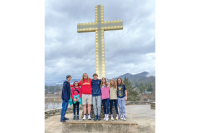Who’s visiting the Smokies?
While conducting a research study a few years ago, tourism official David Huskins came across an Atlanta resident who thought the Blue Ridge Parkway meandered its way through Kentucky.
Another focus group participant said all he knew about the Smokies was what he saw in the movie “Deliverance,” which doesn’t exactly paint a pretty picture of the region.
An African-American woman flipped through travel guides and said while Western North Carolina looked picturesque, she wouldn’t go.
“She said, ‘There’s no one in here that looks like me,’” said Huskins, director of Smoky Mountain Host, a travel promotion organization for the seven counties west of Asheville.
Researching tourists — both real and potential — sometimes amounts to a harsh reality check, according to Huskins. But it’s what he believes is necessary to greatly improve efforts to market Western North Carolina as a tourist destination.
“That’s the thing we’re lacking ... You want the research to drive your marketing decisions,” said Huskins. “Demographics, what people like, don’t like, we need to be doing that on an ongoing basis.”
Related Items
Research can cost hundreds of thousands of dollars, though, making it less feasible for tourism entities operating on tight budgets. The latest study on Western North Carolina scrutinized tourist demographics back in 2008.
Then, the average tourist to the North Carolina side of the Smokies was a 51-year-old Caucasian with a household income of $53,500.
Most visitors traveled without kids and came for the scenery, to relax and to hike. Predictably, the area was rated lowest by past visitors for “nightlife,” “cell phone reception” and “theme parks.”
Changing any of the latter three might assist in attracting younger visitors, but tourism officials are instead promoting ample opportunities to reconnect youth with the great outdoors.
With more and more kids glued to video games, the Internet and their iPods, fewer families are making their way to the Smokies for outdoor adventure.
Still, outdoor recreation and scenic beauty continue to drive millions of visitors to the region every summer and fall. The types of tourists attracted to WNC fluctuate in their numbers, but tourism remains a staple of the region’s economy.
A changing demographic
Decades ago, the bread and butter of summer tourism in WNC came from blue-collar workers employed at textile mills in North and South Carolina.
One factory after another would shut down for a week or two of summer vacation. Each week would bring a new batch of workers who had saved up all year for an annual vacation to the mountains with their families.
But in the 1980s and 1990s, the Carolinas began losing much of their traditional industries, and the mills began closing their doors for good.
With that came a major shift in the kind of tourists who frequented WNC.
“We lost that segment, that blue-collar worker,” said Mary Jane Ferguson, director of marketing for Cherokee. “It’s like a new generation now and new people.”
Driven by nostalgia, some loyal visitors continued returning to the Smokies, along with their kids and grandkids.
For decades, WNC enjoyed a high rate of repeat visitors, which has been both advantageous and problematic.
As the baby boomers devoted to WNC grow older, the target market begins to die out, literally. The goal now is to bring in new visitors who then will restart the cycle.
Capturing the attention of youth is important in keeping visitors coming back for more as they grow old.
“You’re not going to see a 70-year-old rafting down the Nantahala,” Huskins pointed out.
Older visitors concerned about saving up for retirement are also less likely to spend than younger visitors.
“They’re not going to spend money frivolously,” said Ferguson.
Gen Xers have started showing up heavily in the region, and they’ve already distinguished themselves from their predecessors.
“They’re more active; whereas a lot of folks previously had come for natural beauty and the sightseeing, just to rest and relax,” said Lynn Collins, director of the Haywood County Tourism Development Authority.
Gen Xers come to the Smokies for all kinds of outdoor recreation, whether it’s hiking, horseback riding, mountain biking or rafting.
Karen Wilmot, director of the Swain County Chamber of Commerce, confirmed that she, too, was seeing more young, active tourists beginning to visit WNC.
According to Julie Spiro, director of the Jackson County Chamber of Commerce and the Jackson County Travel and Tourism Association, many tourists there are outdoor enthusiasts, ranging from 25 to 45 in age. However, also in the mix are adventurous 50-somethings who come to hike, bike and tent camp.
Spiro said these older visitors are enjoying a renewal of their passion for the outdoors, something that had probably been put on hold as they juggled careers and kids.
Huskins agrees there are a sizeable number of middle-aged couples out mountain biking.
“What we are not seeing is kids on those trails, on those bicycles,” said Huskins.
Families heading elsewhere
Fewer families with young children are flocking to the Great Smoky Mountain National Park for a chance to camp under the stars, according to Huskins.
Kids are not as attracted to the mountains, rivers, rocks and trees as their parents and grandparents were in their childhood.
It’s a trend that concerns Huskins and his colleagues.
“We are an outdoor mecca,” said Huskins. “We’re trying to market the region to get more families interested.”
Losing attractions like amusement park Ghost Town in the Sky and a zoo that had operated in Maggie Valley for decades also put a damper on family visitors.
Ghost Town brought in hundreds of thousands of visitors over the years. After filing for bankruptcy and being plagued by a landslide on top of that, the Western-theme amusement park remains closed for the time being.
“That eliminates a lot of families that would normally come here,” said Collins. “When you all of a sudden don’t have that available, it makes a huge difference in the mix of folks that do come into the area.”
Even if the park reopens, it must reinvent itself if it hopes to draw hundreds of thousands of visitors again, according to Huskins.
“If you’re in the tourism business, you have to reinvent yourself every day,” said Huskins. “It’s got to be more than a rollercoaster and a shoot-out on Main Street.”
Some areas are faring better than others in terms of family visitors, however.
Gem mining in Macon County and the Great Smoky Mountain Railroads in Swain both attract thousands of families to the region.
The Railroad opened a depot in Bryson City in the late 1980s, greatly stimulating the downtown area. Two years ago the railroad moved its administrative offices from Dillsboro to Bryson City and made that depot it headquarters, bringing even more traffic to the Swain County town. Wilmot, who grew up in Bryson City, recalls what the town looked like in the shoulder months before the railroad came along.
“Sidewalks were rolled up. We were gone until Memorial Day,” said Wilmot.
But with the specialty Polar Express train running each winter, Bryson City sees a total of 40,000 riders from November through December.
“That’s a great thing for our local economy in a time we previously had nothing,” said Wilmot.
Now, Bryson City businesses coordinate festivities to complement events at the Railroad. For example, the downtown trick or treat event, coordinated with the Great Pumpkin Patch Express train, draws 3,000 people in just three hours.
Tracking the trends
Changes in tourist demographics would likely seem minute to most lay people, but officials are maintaining watch and picking up on the trends.
Cherokee visitors tend to be more affluent than ever before. The Eastern Band of Cherokee Indians is now marketing toward educated individuals with a household income of more than $75,000.
Cherokee is also focusing on promoting outdoor activities, which have always drawn tourists.
“We’ve always attracted people who enjoy the outdoors and a slower way of life, just being surrounded by beauty,” said Ferguson.
Meanwhile, Swain County has seen an influx of Horace Kephart scholars to visit the famous author’s grave. Bryson City has even come up with an annual celebration in honor of Kephart.
During tough economic times, Jackson County is especially highlighting its outdoor activities that don’t come with a charge.
The Jackson County Chamber is also promoting a free weekly concert series in Sylva this summer.
“Some of the best fun is free,” said Spiro.
With the recession limiting how far most people can afford to travel, Cashiers is seeing more families and young couples from the Atlanta area coming up for the weekend.
“People with money are not flying overseas,” said Sue Bumgarner, executive director of the Cashiers Area Chamber of Commerce. “They’re taking vacations closer to home.”
Cashiers promotes its outdoor offerings, but makes sure not to overwhelm potential visitors.
“We let them know you can come here and be as busy as you want or lazy as you want,” said Bumgarner.
Wilmot concurs, letting visitors know they can spend a lazy afternoon in Deep Creek or enjoy peaceful kayaking on Fontana Lake. If visitors would like to camp without the hassles, guides can do all the grunt work.
“You’re not dealing with a 50-pound pack and two small children,” said Wilmot. “They cook for you, clean up the site for you.”









